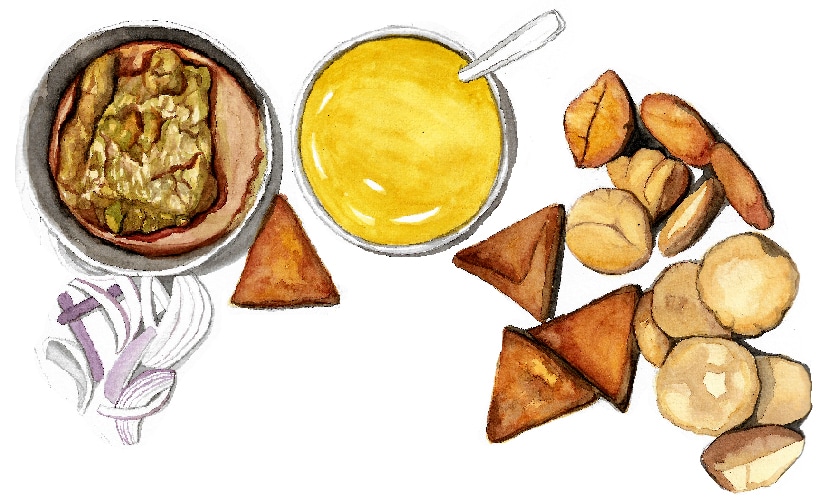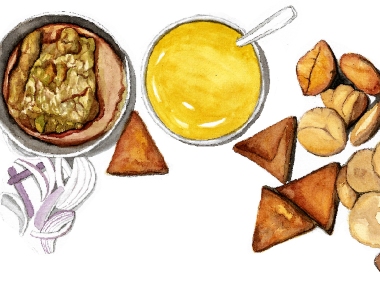When one thinks of the city of Surat, organ meat and dried fish aren’t the images that come to mind. This erstwhile port city is synonymous instead with undhiyu (the winter delicacy made with papdi beans which are available only here) and farsan (snacks) like khamni and locho. In what may come as a surprise, data from the Sample Registration System (SRS) baseline survey by the Registrar General of India reveals that Gujarat has more meat-consuming people than Punjab, Haryana and Rajasthan. Once an important trade centre, Surat is home to about 2.5 lakh Khatris and 4 lakh Ghanchis, who are meat-eating communities. The contribution of these two communities to Gujarat’s culinary landscape is an array of meat gravies, kebabs, biryanis and vegetables cooked with meat, among other dishes, and the real diversity and flavour of the state’s non-vegetarian food are to be found in home kitchens and personal recipe diaries. While Ghanchis were traditionally in the business of owning provision stores and oil pressers, Khatris had textile looms. People from these communities marry within the same caste — and sheri (lane) — and therefore their population is concentrated in the city itself. “You will see traces of Mughal culinary influences in our cuisine,” says Chef Dolcee Bachkaniwala, a Khatri, who was a contestant of Masterchef India Season 2 and runs a cooking institute in Surat. Golwad, the area where the other meat-eating community — the Golas — stay, Makaipul and Nanpura are some of the popular meat markets in Surat. For most, meat is not an indulgence but rather a routine part of everyday meals. [caption id="" align=“alignnone” width=“825”]  During Kerigado, Khatri families offer an elaborate non-vegetarian meal along with aam ras. Illustration by Shawn Dsouza[/caption] “They say ‘khatri ni jeeb ne daam devo che’ which means a Khatri’s tongue should be burnt with hot coal, because all the laborious cooking could be done away with,” Ami Jariwala, a chartered accountant and home cook jokes about her culinary heritage. Some traditional dishes made by these two communities include the green garlic-sprinkled lasan kaachu, which is made with chicken liver and runny eggs, and a Khatri mutton delicacy called tapelu, which is slow roasted on a wood fire in a large vessel called ‘tapela’. Tapelu tastes better when cooked in a large quantity, and Khatri weddings call for a dedicated day when tapelu is prepared. The dish has a special place in menus prepared for festivities and occasions. Jariwala describes tapelu as being a “popular, oil-slicked and heat-filled dish that leaves reddish-orange stains on the plate” which is eaten with fermented, bite-sized puris. She takes me through many of the lesser-known delicacies, “What are not-so-commonly available are dishes like khariya (legs, bone marrow), mutton samosas, papdi ma mutton (non-vegetarian undhiyu), papdi ma khariya, mesoor, kaanda maamna, kaanda-jheenga (prawns), dara ni biryani (rice cooked with Indian salmon), mutton biryani, hojri-fefsa (the stomach and lungs of a goat), and talli-kaleji (liver) among others.” Such recipes are considered heirlooms. Neither the meat nor the ingredients and cooking techniques are singular to Ghanchis or Khatris, but the taste of the food prepared in no two households is the same. Hemali Bodiwala, who runs a catering business, says that it is the chicken masala that lends a unique flavour to Ghanchi food. Her bheja masala made in a red gravy and kaleji prepared in a green masala are favourites among Surtis. Each family in the city also has its own unique ‘green masala’. “The proportion of green chilly, ginger, garlic (green garlic in winters) and fresh turmeric root is critical. We don’t use turmeric powder. Our garam masala is also different. There are few stores in Surat which sell this garam masala, such as the Cheeba Gandhi store,” says Chef Dolcee Bachkaniwala. During the cooler months of the year, Surat’s markets see an influx of fresh green garlic (surti leelo lasan), which is strong in flavour and tender in texture. Women cooks are most particular when it comes to the way this garlic is chopped; it has to be very finely done. One dish where this type of garlic features prominently, the mutton nu kacho, is a raw mutton dish where the meat is mashed, kneaded like dough, and finally cooked using the heat of the garlic, says Chef Bachkaniwala. Gujarat boasts of a long coastline with fresh fish available easily, and the Ghanchi community’s favourite is the bumla (Bombay Duck). It contains high water content and the wisdom passed down generations is that if you don’t cook it right, it could turn lumpy. “When fresh bumla isn’t available, my mother dips into her stash of dried bumla. You soak it in water and refresh it, and cook it with fried kanda (onion) and spices,” says Vicky Modi, a Ghanchi food enthusiast. [caption id="" align=“alignnone” width=“825”] .jpg) Khatri weddings call for a dedicated day when tapelu is prepared. Illustration by Shawn Dsouza[/caption] Because Gujaratis are viewed as being conservative, many are unaware that the offerings some communities make to their family deities also consist of meat dishes. “The Bagdawala families offer jhinga-baigan (a dish made with prawn and brinjal), whereas other gotras offer kaanda-maamna for kuldevi pujas (prayers offered to family deities)," Ami Jariwala says. “Dalwalu mutton (goat cooked in lentils) is eaten on the Kagdi Teej fast which falls on the fourth day of Rakshabandhan. Kerigado is another awaited occasion; Khatri families offer an elaborate non-vegetarian meal along with aam ras (mango pulp) for all their relatives. ‘Gado’ means time span in Gujarati. This gathering is held to celebrate the king of fruits with mutton samosas, maamna (kheema kebab) and a variety of chicken dishes,” Chef Bachkaniwala adds. On auspicious days when fasts are observed, the Khatri community permits the consumption of fish. In fact, on the Gujarati New Year, they consider eating pomfret (called paaplet, cooked in a pungent green masala) propitious. Though the younger members of these communities are averse to how oil-laden many of these dishes are, they are still drawn to the flavours. The popular Surti saying ‘margi ne daru, jiv ne saru’ (life is good when there’s alcohol and chicken) still rings true, despite the passage of time. *** Chef Dolcee Bachkaniwala’s tapelu Ingredients: Oil - one-fourth of a cup Cinnamon sticks - two Cloves - five to six Mutton - one kilo Salt to taste Onion - 750 grams; cut into only four pieces, one cut vertically and one cut horizontally Green masala: A paste made of green chilly, garlic, ginger, and turmeric, 30 grams each Red chilly powder - two to three teaspoons Garam masala powder - three to four teaspoons Method: 1. Heat the oil in a heavy-bottom, deep brass sauce pan. Put in the cinnamon and cloves, and sauté the mutton chunks 2. Add salt. When the mutton releases water and starts turning white (roughly five to six minutes after you start cooking) add the onion to the pan. Don’t stir; spread the onions and cover the pan 3. Cook for 30 minutes in this manner. Take off the lid and check to ensure that the mutton and onions aren’t sticking to the bottom of the pan. Stir only if necessary 4. Sprinkle the green masala, red chilly powder and garam masala powder. Cover the pan again and allow the dish to cook 5. Pour some water on top of the lid covering the pan. After 15 minutes pass, remove the lid and give the dish a gentle stir. Check if the mutton is done and if the dish needs seasoning 6. Let it again cook for another 20 to 30 minutes 7. A tadka of watermelon seed powder, cashew powder and garam masala powder made in oil can be added. Add salt as required Ami Jariwala’s bumla Ingredients: Bombay Duck - 500 grams; cut into two to three pieces horizontally and clean from within | Note: Put the cleaned fish on a thick cloth, so all the excess water is soaked out of it Green chillies - 10-15 Garlic - one big bulb/ seven or eight cloves Dhania powder - seven to eight tablespoons Jeera powder - two to three tablespoons Garam masala - one teaspoon Turmeric powder - one teaspoon Fenugreek seeds - 15-20 Lemons - three to four, juiced Jowar flour - one tablespoon Oil (preferably groundnut oil) Sea salt n table salt (add to taste) Method: 1. Grind the green chillies, garlic, two tablespoons of oil and sea salt together in a mixer and turn it into a paste 2. Pour four to five tablespoons of oil into a bowl. Add the above paste, dhania powder, jeera powder, garam masala, lemon juice and jowar flour. Combine to form a paste, check for taste — it should be a little spicy but more tangy 3. Add in the fish pieces and mix well 4. Pour four to five tablespoons of oil in a pan and add fenugreek seeds. As soon as they pop and turn brown, transfer the contents of the bowl into the pan. Spread the fish evenly in the pan so that the pieces cook evenly 5. Do not stir or flip the fish. To ensure that the meat is cooking evenly, you can also keep rotating the pan on the stove. As soon as the fish lets out oil, it it ready to serve 6. Garnish with finely chopped coriander leaves This fish does not take long to cook on the stove and can be prepared within 15 minutes. It tastes best when served with jowar no rotlo (millet flatbread). Illustrations by Shawn Dsouza
In what may come as a surprise, Gujarat has more meat-consuming people than Punjab, Haryana and Rajasthan. The culinary landscape of Surat in particular is moulded by the Ghanchi and Khatri communities, who have an affinity for mutton and fish and include meat in both everyday meals and special feasts
Advertisement
End of Article


)
)
)
)
)
)
)
)
)



